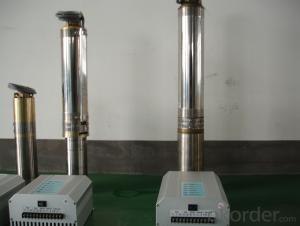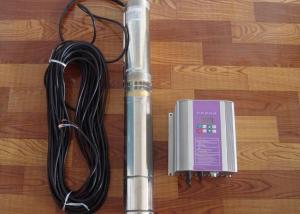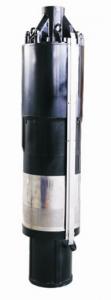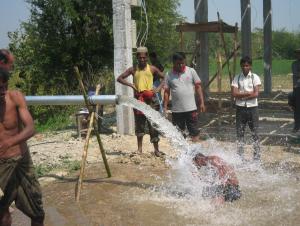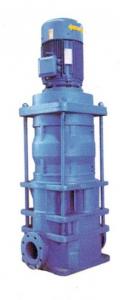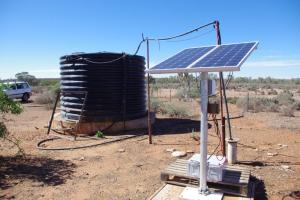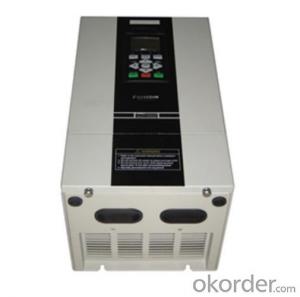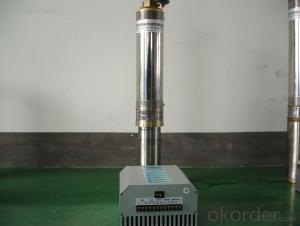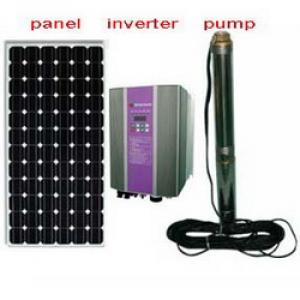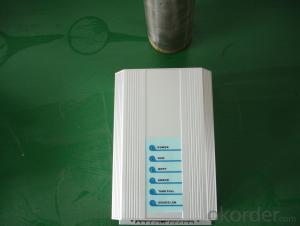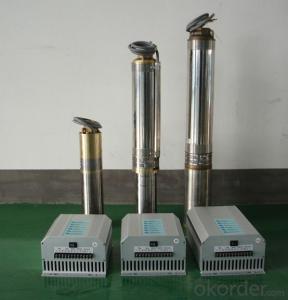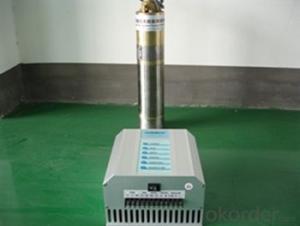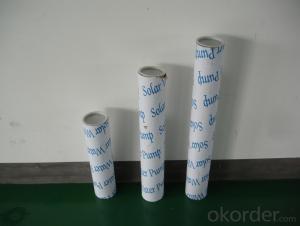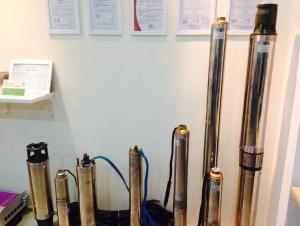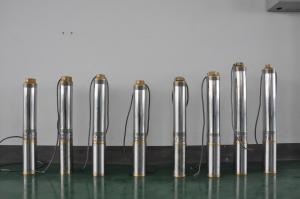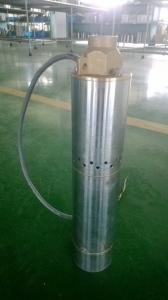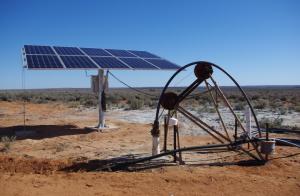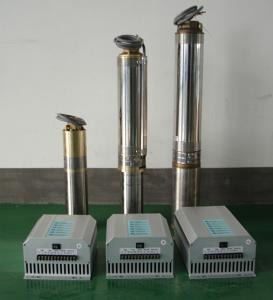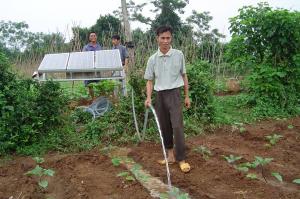DC Solar Water Pump
- Loading Port:
- China Main Port
- Payment Terms:
- TT OR LC
- Min Order Qty:
- -
- Supply Capability:
- -
OKorder Service Pledge
OKorder Financial Service
You Might Also Like
Item Description :
This superb new addition to our solar fountain range comes with a 10w solar panel,and a powerful fountain pump that is capable of producing fountains of up to 2m in height. As well as being easy to set up and use.Instruction manual is supplied for assembly and maintenance.
Solar Fountain Key Features :
Powered by direct sunlight
No high voltage electric mains required
Safe for children
Max. height of fountain: 2M
Max. flow capacity: 800 L/H(176 GAL)
10W Polycrystalline solar panel included
18V DC brushless pump
Solar Pump Features :
Can produce fountains up to : 2M (tube height) 1.4M (fountain height)
Comes with multiple nozzle accessories
Cable Length : 5M
Solar Panel Features :
10W peak power.
Polycrystalline highly efficient solar panel
Comes mounted in aluminium frame
Comes with ground stake and rotating knob so you can angle your panel toward the sun
What You Will Get :
10W solar panel
Solar pump
Ground Sake
Nozzle accessories
Precautions :
DO NOT alter or change the product itself or its components
Operate pump in freshwater only, never above 50 degrees celsius
Keep away from flammable liquids
Do not connect to any other power supply other than the included
- Q: Are there any safety measures or precautions to consider when using a solar pump?
- Yes, there are several safety measures and precautions to consider when using a solar pump: 1. Electrical Safety: Solar pumps may generate electricity, so it's important to follow electrical safety guidelines. Ensure that all wiring and connections are properly insulated and protected from water or physical damage. Use a circuit breaker or disconnect switch to shut off power when performing maintenance or repairs. 2. Water Safety: When working with a solar pump that draws water from a well or pond, be cautious of potential water contamination. Use a suitable filtration system to remove impurities and regularly clean and disinfect the water source. Additionally, ensure that the pump is properly sealed to prevent water from entering critical components. 3. Overheating Prevention: Solar pumps rely on sunlight to generate power, and excessive heat can reduce their efficiency or damage components. Install the pump in a shady area or use a protective cover to shield it from direct sunlight, especially during peak hours. Regularly check for any signs of overheating, such as melted wires or burnt smells. 4. Maintenance and Inspection: Regular maintenance and inspections are crucial to ensure the safe and efficient operation of a solar pump. Follow the manufacturer's guidelines for routine checks, cleaning, and lubrication. Inspect the pump's components, such as panels, wiring, and valves, for any signs of wear or damage. Promptly address any issues to prevent further complications. 5. Installation and Mounting: When installing a solar pump, carefully follow the manufacturer's instructions and guidelines. Ensure that the pump is securely mounted to prevent any accidental falls or damage. Use appropriate mounting brackets or structures that can withstand the weight and environmental conditions. 6. Training and Education: It is essential to have adequate knowledge and training on the operation of solar pumps. Understand the pump's specific features, controls, and safety precautions. If necessary, seek professional assistance or training to ensure safe and effective use. By following these safety measures and precautions, users can minimize the risk of accidents, optimize the performance of their solar pump, and ensure its longevity.
- Q: How does the size of the solar panel affect the performance of a solar pump?
- The size of the solar panel directly affects the performance of a solar pump. A larger solar panel has a higher power output, which means it can generate more electricity to power the pump. This results in increased water flow and pumping capacity, allowing the pump to operate more efficiently and effectively. On the other hand, a smaller solar panel may not be able to generate enough power, leading to reduced performance and potentially lower water output.
- Q: Can a solar pump be used for water supply in refugee camps or emergency situations?
- Yes, a solar pump can be used for water supply in refugee camps or emergency situations. Solar pumps are ideal for such scenarios as they are reliable, cost-effective, and environmentally friendly. They can operate without the need for electricity or fuel, making them suitable for remote areas with limited infrastructure. Additionally, solar pumps can provide a consistent supply of clean water, ensuring that the basic needs of individuals in refugee camps or emergency situations are met.
- Q: What size solar pump do I need for my application?
- The size of the solar pump you need for your application depends on various factors such as the water flow rate required, the total dynamic head (TDH) or the vertical distance the water needs to be pumped, the distance of horizontal piping, and the available solar energy in your location. It is recommended to consult with a professional or a solar pump supplier who can assess your specific requirements and provide you with the most appropriate size for your application.
- Q: Are there any restrictions on the use of solar pumps in certain regions or countries?
- Yes, there can be restrictions on the use of solar pumps in certain regions or countries. Some countries may have regulations or policies in place that govern the installation and operation of solar pumps. These restrictions could be related to factors such as environmental impact, water usage regulations, or electrical safety standards. Additionally, certain regions or communities may have specific requirements or limitations due to their unique geographical or social circumstances. Therefore, it is important to research and comply with the local regulations and restrictions before installing or using solar pumps in specific regions or countries.
- Q: Are there any limitations to the flow rate of a solar pump?
- A solar pump's flow rate is subject to limitations. This is influenced by the pump's size and capacity, the power output of the solar panels, the intensity of sunlight, and the depth of the water source. If the pump is not appropriately sized or the solar panels lack sufficient power, the flow rate may be reduced. Moreover, if the water source is deep, the pump may face greater pressure, further restricting the flow rate. To guarantee optimal flow rates for the intended use, it is crucial to consider these limitations and accurately size and design the solar pump system.
- Q: Can solar pumps be used for both residential and commercial purposes?
- Yes, solar pumps can be used for both residential and commercial purposes. They are versatile and can be utilized for various applications such as water supply, irrigation, and heating systems in both residential and commercial settings. Solar pumps are a sustainable and cost-effective solution for both sectors, helping to reduce electricity bills and reliance on traditional energy sources.
- Q: Are there any maintenance requirements specific to the solar panels used in a solar pump system?
- Yes, there are some maintenance requirements specific to the solar panels used in a solar pump system. Here are a few important ones: 1. Cleaning: Solar panels can accumulate dust, dirt, and other debris over time, which can reduce their efficiency. Regular cleaning is essential to ensure optimal performance. This can be done using a soft cloth or sponge with water and mild detergent. However, it is important to follow manufacturer guidelines and avoid using abrasive materials that could damage the panels. 2. Inspections: Periodic inspections are crucial to identify any potential issues such as loose connections, cracked glass, or damaged wiring. Regularly check the panels for signs of wear and tear, and ensure that all connections are secure. If any problems are detected, prompt repairs or replacements should be carried out to avoid further damage. 3. Shading: Solar panels rely on direct sunlight to generate electricity, so it is important to ensure that they are not shaded by trees, buildings, or other obstructions. Regularly monitor the surrounding area to identify any new sources of shade that may have developed over time. If shading is unavoidable, consider adjusting the positioning of the panels or using shading mitigation techniques like trimming trees. 4. Monitoring performance: Keep an eye on the performance of your solar pump system by monitoring the energy production and water output. If you notice a significant drop in performance, it could indicate a problem with the panels. In such cases, it is advisable to contact a professional technician to diagnose and resolve the issue. 5. Extreme weather conditions: Solar panels are designed to withstand various weather conditions, but extreme weather events such as hailstorms, heavy snowfall, or high winds can potentially damage them. It is important to take necessary precautions to protect the panels during such events, such as covering them or temporarily disconnecting them if severe weather is expected. Overall, regular maintenance and monitoring of solar panels in a solar pump system are essential to ensure their longevity and optimal performance. Following manufacturer guidelines and seeking professional assistance when needed can help in identifying and addressing any issues promptly, thereby maximizing the efficiency and lifespan of the system.
- Q: Are solar pumps noisy?
- No, solar pumps are not noisy. They operate quietly and do not produce any significant noise or vibrations.
- Q: Can a solar pump be used in areas with high temperatures?
- Yes, a solar pump can be used in areas with high temperatures. Solar pumps are designed to operate in various environmental conditions, including high temperatures. They are engineered to withstand heat and can continue to function effectively even in hot climates.
Send your message to us
DC Solar Water Pump
- Loading Port:
- China Main Port
- Payment Terms:
- TT OR LC
- Min Order Qty:
- -
- Supply Capability:
- -
OKorder Service Pledge
OKorder Financial Service
Similar products
Hot products
Hot Searches
Related keywords
